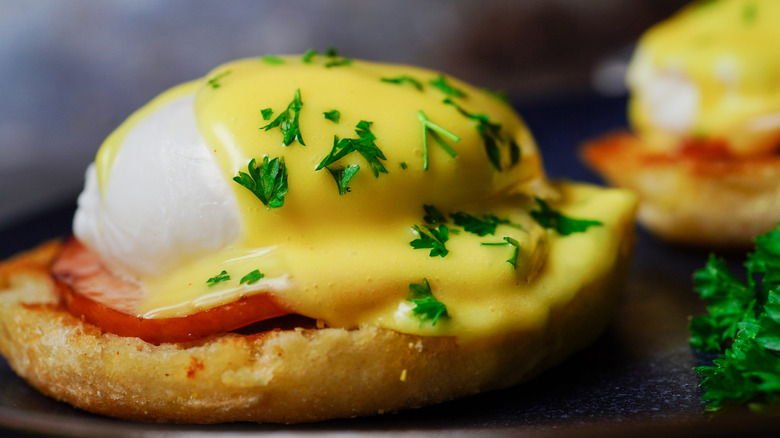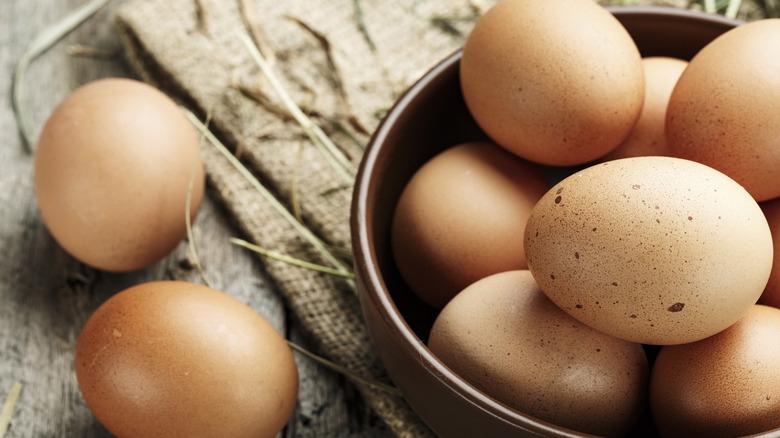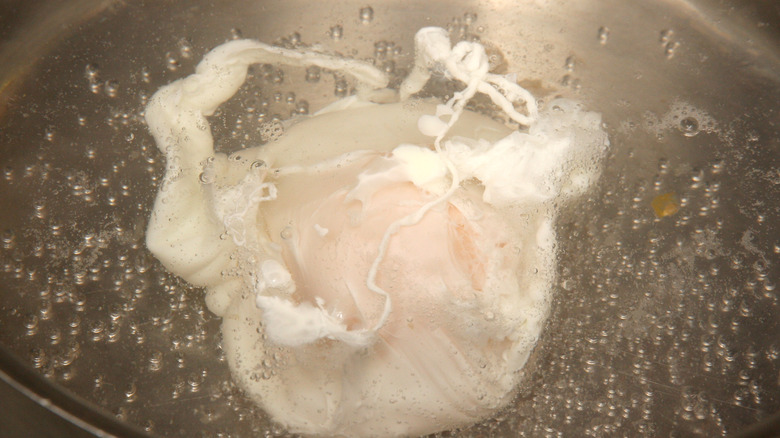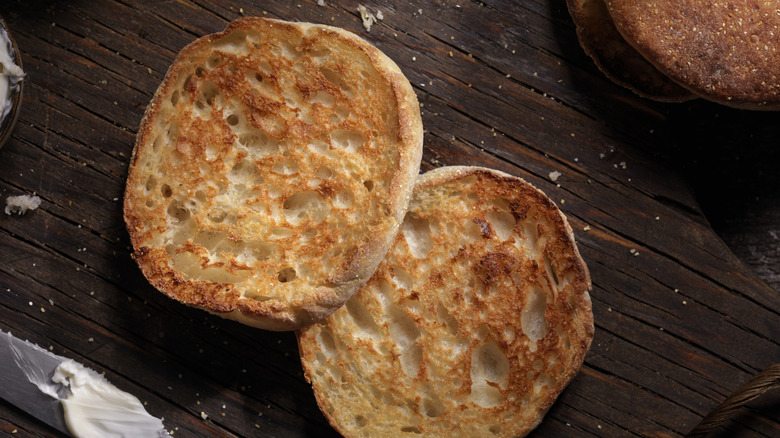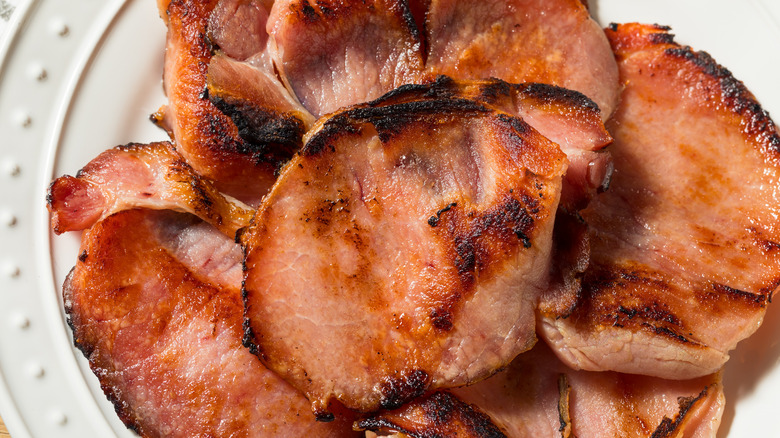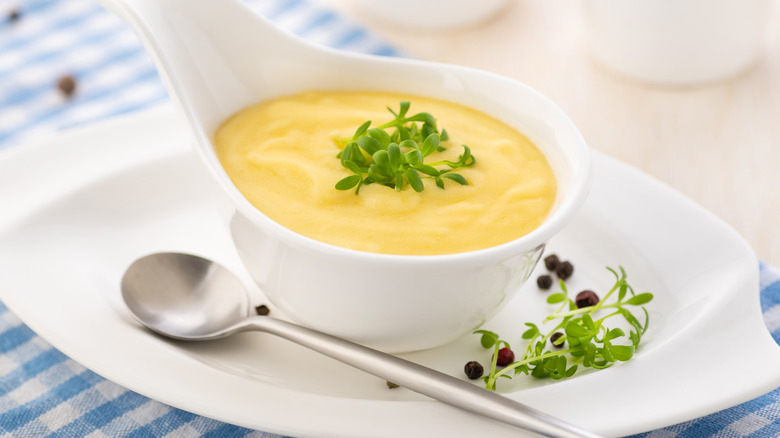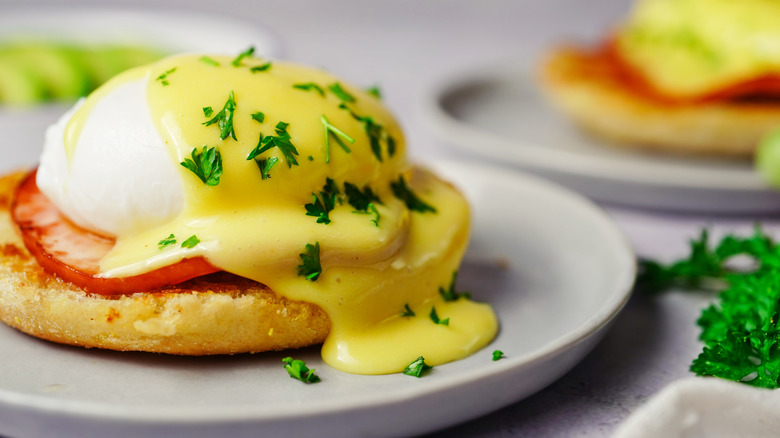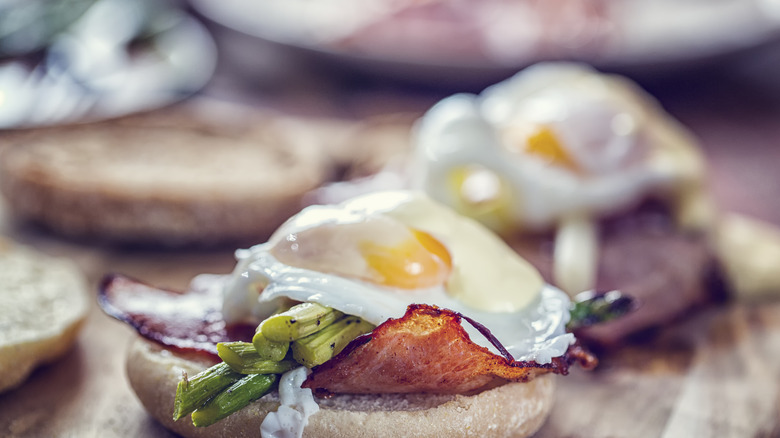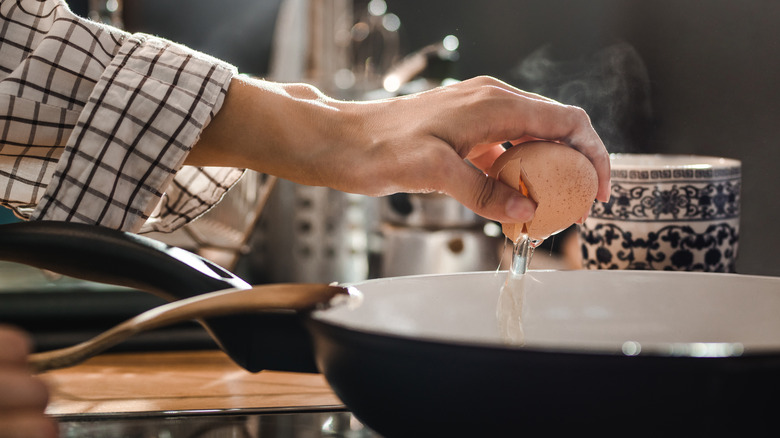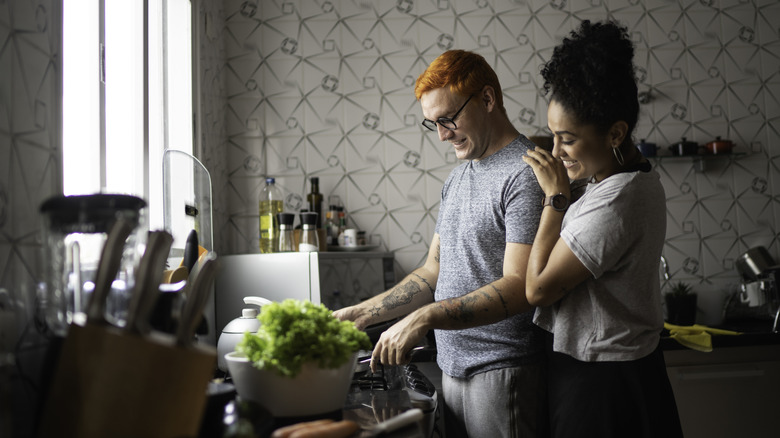12 Tips You Need To Master Eggs Benedict
Eggs Benedict is a classic brunch dish with a somewhat mysterious origin story. Some people believe that a regular of Delmonico's Restaurant in New York (socialite LeGrand Benedict) is its namesake. Still, others believe a different Benedict (New York stockbroker Lemuel Benedict) ordered the fatty dish to combat a night of overindulgence. This mystery resulted in a culinary delight that can be a challenge to master.
But this is work worth doing. When you set your finished plate down, the payoff is enormous: a domed, perfectly poached egg perches atop a crunchy, golden English muffin. A crusted slice of Canadian bacon peeking out, all napped with a sunshine-yellow sauce that has a texture like the finest velvet.
Although the origin of eggs Benedict — the celebrated scion of brunch tables across the globe — is the subject of debate, one thing is certain: It's definitely not a dish that gives up its secret delights easily. However, with the right techniques and some practice, you can create an eggs Benedict that rivals those served in the finest restaurants.
Use quality ingredients
The foundation of any great dish lies in its ingredients' quality, which is true of eggs Benedict. This dish is crafted from simple ingredients, elevated by cooking techniques. Because of this, each part of the dish must be fresh.
The best eggs produce the most beautiful, silky poached yolks. Look for packaging that indicates free-range or cage-free animals and a seal that certifies humane treatment by the producer, and check their freshness before you begin. Fill a bowl with water, and place the eggs in one at a time. Fresh eggs will sink to the bottom and rest on their sides. Eggs that are old stand on one end and float. Air has entered the egg, and the flavor (and safety) is questionable.
Now turn your attention to the meat. Canadian bacon is cured meat from the back of the pig. It is leaner than regular bacon but no less flavorful. It resembles ham, but ham comes from the hind leg of a pig (and Canadian bacon from the loin). Because it is already cured, the flavor must be impeccable from the start.
Finally, start with unsalted butter for your hollandaise, and use plump, juicy lemons. This lets you control the salt level in the final dish and adds a burst of brightness. And don't forget the English muffin. Experienced bakers might make their own English muffins, but if that's not you, check the date on the packaging to ensure they are fresh.
Practice poaching perfection
Achieving the perfect poached egg is crucial for eggs Benedict. Poaching eggs is an advanced technique but easy to master with practice. There are multiple methods to poach eggs — whichever gets the job done for you is the best.
The traditional method might be the most fool-proof: Use fresh eggs, and bring a pot of water to a gentle simmer with a dash of vinegar. Create a gentle vortex in the water and slide the egg into the center. Cook for 3-4 minutes for a runny yolk. Remove with a slotted spoon and drain excess water.
Some chefs oil-poach their eggs. The flavor produced by this method is more like a fried egg and might overwhelm a delicate hollandaise, but it's worth a try for eggs and toast. You can also poach an egg in the microwave by adding it to a mug of water that's been heated, zapping it for 30 seconds at a time until it's poached. Other methods include poaching in an Instant Pot, utilizing a sous vide setup, and cracking the egg into plastic wrap before lowering it into the water (to maintain its shape).
For a different flavor profile, consider changing up the poaching liquid. Shakshuka uses tomato juice to poach eggs gently, but you can also fill your poaching pot with stock, cream, wine, or bouillon. Regardless of the method, getting the consistency you want might take some time. Experiment until you can poach eggs fearlessly.
Toast your muffins
Toasted English muffins provide a sturdy base for your eggs Benedict. Many people neglect to pay attention to this element of the dish, but it is the foundation upon which all other flavors are layered.
Toasting your muffins until they are golden brown and slightly crispy prevents them from becoming soggy when you add the poached egg and hollandaise sauce. Use a standard toaster, or add another flavor by grilling them. This faint smokiness cuts through the richness of the hollandaise and provides a counterpoint to its lemony kick.
Another way to get your muffins toasty is in the skillet. Butter your muffins and place them in a warm skillet, butter side down, until they turn golden. This does add to the calorie count in your eggs Benedict, but chances are good you're not counting if you're making this dish. But this method does leave the underside of the muffin untoasted, so keep that in mind.
Sear the Canadian bacon
As noted above, Canadian bacon is cured pork loin, generally sliced about an eight to a quarter-inch thickness. It does not require long cooking or seasoning, but searing it well adds depth of flavor and a nice texture to your eggs Benedict. Searing triggers the Maillard reaction, a chemical change that occurs when meat browns. This develops flavor quickly without additional ingredients.
Pan-frying with butter in a hot skillet is the best way to get the job done, but it's not the only way. If you prefer to avoid grease splatters that can occur when pan frying, preheat your oven to 400 F and bake for 10 to 15 minutes. If you want to add more color (and flavor), use the broiler, knocking the time down to just 3 to 4 minutes per side.
You could also simply warm the Canadian bacon in the microwave, but that misses the point entirely. Yes, your bacon is warm, but it lacks the caramelization and flavor that frying or baking produces.
Master the hollandaise
Hollandaise is one of the French mother sauces that professional chefs take years to master. Because of this, it might seem impossible to get it right in your own kitchen, but that's just not true. Hollandaise requires specific ingredients at particular temperatures, combined with a technique that can be learned.
Start by melting the butter and setting it aside. Using a double boiler and just egg yolks, whisk the yolks, lemon juice, water, and a pinch of cayenne pepper until doubled in volume. You can use a hand mixer on low if whisking is a challenge. Keep the water in the double boiler at a low simmer to gently cook the egg yolks.
Once the egg mixture is ready, slowly add the melted butter as you whisk. Keep the liquid moving — slacking off at this stage can result in lemony scrambled eggs. You're looking for a creamy, velvety texture that coats the back of a spoon. Once that happens, remove the sauce from the heat and season with salt and pepper to taste.
If you want to skip all the drama and update the technique, making a classic hollandaise sauce in a blender is possible. Just toss all ingredients in a blender and blend on high for a minute or two. The eggs must be absolutely fresh for this method, as it is not cooked.
Keep everything at the perfect temperature
Temperature is key when it comes to every aspect of eggs Benedict. Throwing together a dish with such temperamental elements means either hiring an assistant to make the sauce and fry the bacon while you poach the eggs — or coming up with a system to maintain everything at the correct temperature until it's time to assemble.
Take a tip from hotels that serve hundreds of plates of eggs Benedict in a hurry. Place your eggs gently in a bowl of ice water when you are finished poaching. This will stop the cooking, leaving the yolk runny. When ready to serve, these eggs can be placed briefly in a bowl of simmering water to warm them.
Hollandaise can be a little trickier. One way to keep it at temperature is to pour the finished sauce into an insulated container. This keeps it warm without continued cooking, which can cause it to break. Some chefs hold the hollandaise in a bain marie. Place the bowl of finished hollandaise into a pan filled with simmering water (not on the heat — just in a pan with water). Theoretically, this serves the same insulating purpose as a thermos, but it can be difficult to manage in practice.
Season in layers
One thing that continually separates professional chefs from home cooks is seasoning. Seasoning is nothing more than adding the proper amounts of salt and pepper at the appropriate time during cooking. In the end, no dish should taste of either salt or overwhelmingly of pepper. Instead, salt and pepper lifts each ingredient into the best version of itself.
Too many home cooks make the mistake of simply adding salt to the finished dish. While this can add an interesting contrast when the salt is meant to foil a sweet ingredient, this often leaves diners with a mouth-tasting of the sea and not much else. To prevent this, season your dish in layers.
Salt should never be added to the poaching liquid for eggs — it will cause the egg whites to become wispy and thin instead of wrapping around a firm yolk. Add a sprinkle on the finished egg once it's placed on the muffin. Cayenne pepper should also be added with a judicious hand. Taste once your hollandaise is cooked and season with more salt and pepper, just a little at a time, to find the subtle spice that complements the rich yolk and bright citrus.
Assemble properly
Everything is poached, emulsified, and toasted to perfection. It's time to assemble. Don't fall down on this important step. It requires just as much care as every other element up to this point. Eggs Benedict is as much about presentation as it is about taste. Start by arranging the toasted muffins on the plate. Do not make the mistake of buttering your English muffins, as delicious as that might sound. This can throw the dish's balance off, overwhelming the lemon in the hollandaise and masking the flavor of the yolk.
Add the seared Canadian bacon and top with one poached egg per muffin on a plate. The crowning glory, your beautiful hollandaise, is the visual star of the show. Don't be shy with the sauce, but don't drench your eggs either. The goal is the perfect nap — not a brief snooze but the French term for covering food with a thin, even layer of sauce. Your hollandaise should be smooth enough to stay where you put it without being a gloppy mess.
Finally, add some fresh chopped parsley or chives for color and flavor. Will the eggs Benedict taste delicious without fresh herbs? Likely. But will it look as pretty? Not so much. Fresh herbs elevate your cooking and add a more professional touch.
Don't be afraid to experiment with variations
Eggs Benedict does have a formula; each ingredient is specific to this dish. But that doesn't mean you can't go off-script and craft your own delicious variations. Start simply by swapping smoked salmon in for the Canadian bacon, and you have yourself a luxurious eggs Benedict with salmon (known as eggs Royale), but certainly don't stop there.
Start at the bottom and remaster the English muffin. Turn it into a waffled eggs Benedict, with a plain waffle or one with chopped spinach, fresh herbs, or a mild cheese. Get spicy and try a Cuban sandwich-inspired eggs Benedict. This version features slow-roasted pork shoulder, a slice of Swiss cheese, and the classic hollandaise. Throw a few pickles underneath the poached egg to really live la vida loca.
Bump up your daily veggie intake and add sliced avocado, or sauté some spinach and layer it on top of the Canadian bacon. Use regular bacon or last night's leftover steak. The hollandaise is the one consistent element that unites all delicious parts of this breakfast beauty, but everything else is up for grabs.
Get your timing right
The timing of this dish is tricky, which is why more home cooks don't try to create it. But it is possible to cook eggs Benedict to order with some planning. The secret is in your mise en place. Mise en place means "everything in place," and it's the key to many challenging dishes. Having all ingredients and tools ready to go and close at hand means you won't waste time fumbling around measuring out your lemon juice or separating eggs.
Start by cracking each egg you'll poach in an individual dish while you heat your poaching liquid. Measure the ingredients for your hollandaise, and set up your double boiler while you melt the butter. Place your English muffins in the toaster, and get a thermos ready to hold your hollandaise and a pan of ice water for your poached eggs if you won't be serving them right away. The Canadian bacon can be fried ahead of time and kept warm in a low-heat oven, and don't forget to chop your fresh herbs, too.
Have plates ready to go. These can be kept warm in the oven along with your Candian bacon — it's a nice touch that mimics how upscale brunch restaurants serve their eggs Benedict. When it's time to cook, everything is ready to go. Ensure you've read your recipe through so you know what's coming next without continually checking.
Practice makes perfect
There's a saying about breaking eggs to make omelets, and nothing could be more accurate than when it comes to mastering eggs Benedict. There are a million ways to "fail" at this dish — even seasoned cooks sometimes struggle with the techniques needed to bring it all together.
But like any culinary skill, practice is essential. Don't be discouraged if your first attempts are not perfect. Sometimes, the eggs are not as fresh, and your whites get away from you. Maybe the water temperature is too hot, and your timing is off, ruining that perfect yolk.
Perhaps sauces are your nemesis, and your hollandaise is giving you fits. Or you add the right thing at the wrong time. Whatever you do, don't panic. Poaching eggs and making sauce is challenging for any cook — many study for years to get consistently perfect results. Keep honing your poaching, toasting, and sauce-making skills to achieve mastery.
Enjoy the process
While it seems that some home cooks glide effortlessly from one complicated plate to another, the reality is that many of them spend years perfecting the techniques that allow them to pull together a flawless dish. These techniques are so challenging that culinary schools charge thousands of dollars to learn them. And how do students learn them? By practicing over and over again to understand why food behaves the way it does and the best way to prepare ingredients.
This process can sometimes seem tedious, it's true. But consider this: Poached eggs that break when you remove them from the pan are still delicious. A hollandaise that separates can be rescued. Toasted English muffins that are browner than you might like just need a little butter (or hollandaise sauce!) to make them shine. Cooking should be a pleasurable experience, and mastering this classic dish can be a rewarding culinary journey. If you think of it more as a learning process than a slog through finicky techniques, you are more likely to enjoy whatever the final result is.
